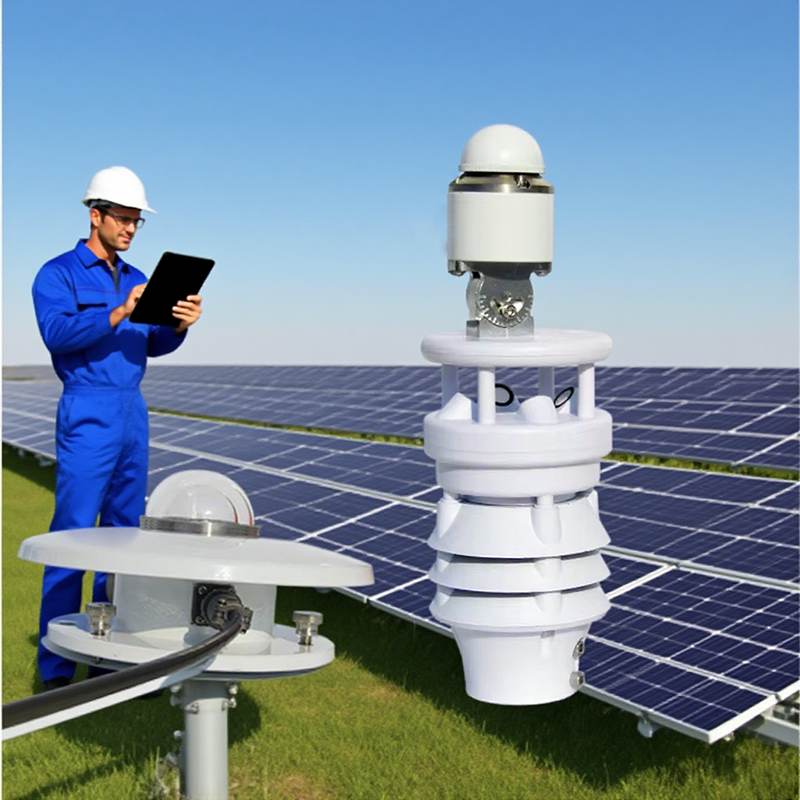For utility-scale solar power stations, every watt of electricity generated is directly related to the economic lifeline of the project – the return on investment. In the pursuit of higher efficiency, operational strategies are shifting from simple “power generation” to “precise power generation”. The core of achieving this transformation lies precisely in those sophisticated instruments that work silently under the sun: advanced solar radiation sensors. They are no longer simple data loggers but key technologies for maximizing project return rates.
Beyond “Sunshine Hours” : The Commercial Value of Precise Radiation Data
Traditional power generation assessment may rely solely on the rough concept of “sunshine hours”. However, for a power station with an investment of hundreds of millions of dollars and a life cycle of over 25 years, such vague data is far from enough.
Advanced radiation sensors, such as Pyranometers and Pyrheliometers, can precisely measure different forms of solar radiation:
GHI (Global Level Irradiance) : Measured by Pyranometers, it is the basis for evaluating the performance of fixed-tilt photovoltaic systems.
DNI (Direct Normal Irradiance) : Measured by Pyrheliometers, it is crucial for photovoltaic power stations and solar thermal power stations with tracking systems.
DHI (Scattering Level Irradiance) : Also measured by Pyranometers (in conjunction with light-blocking devices), it is used for precise irradiance models.
These data, accurate to watts per square meter, constitute the “gold standard” for the performance assessment of power stations. They are directly used to calculate PR (performance ratio) – the most crucial indicator for eliminating the impact of weather fluctuations and measuring the health and efficiency of the power station itself. A minor increase in PR can mean millions of dollars in additional power generation revenue throughout the entire life cycle of a power station.
Evolution of sensor Technology: From Basic Monitoring to intelligent Prediction
The core sensor technology in the market is already very mature, but it is still constantly evolving to meet higher requirements:
High precision and reliability: ISO 9060:2018 Class A & B certified sensors provide the precision and long-term stability required by the industry, ensuring data credibility.
Integration of Solar Monitoring Systems: Modern sensors are no longer isolated devices. They are seamlessly integrated with data loggers and SCADA systems to form a complete Weather station for Solar Farms. These weather stations usually also contain reference batteries for cross-validation with physical radiation measurements.
The rise of Soiling Measurement: The power generation losses caused by pollution such as dust and bird droppings are astonishing. Specialized Soiling Monitoring Systems directly quantify pollution losses by comparing the outputs of clean and exposed reference batteries in the environment, providing a scientific basis for precise cleaning and avoiding the waste of water resources and costs caused by blind cleaning.
Solar Irradiance Measurement for PV Performance and Forecasting: High-precision radiation data from ground measurements are the basis for training and calibrating power generation forecasting models. More accurate short-term predictions can significantly reduce penalties in the electricity market and optimize grid dispatching.
Return on Investment Analysis: How does Precision Sensing Directly Generate Revenue
Investment in precision sensing technology is directly translated into a higher ROI in the following ways:
Enhance power generation: Through precise O&M (Operation and Maintenance), promptly identify efficiency losses caused by component failures, inverter issues, or obstructions.
Reduce operating costs
Precise cleaning: Arranging cleaning based on pollution monitoring data can save up to 30% of cleaning costs while maximizing power generation revenue.
Intelligent diagnosis: By analyzing the deviation between radiation data and actual power generation, fault points can be quickly located, reducing inspection time and labor costs.
Reduce financial risks
Power generation guarantee: Provide undisputed independent data for power station owners and investors to verify whether the power generation volume as stipulated in the contract has been reached.
Optimizing electricity trading: Accurate predictions can help power stations sell electricity at the best price in the electricity market and avoid fines caused by prediction deviations.
Extending asset lifespan: Continuous performance monitoring helps identify potential issues, preventing minor malfunctions from evolving into major losses, and thereby safeguarding the long-term value of assets.
Conclusion: Precise data – the cornerstone of future solar asset management
In the increasingly competitive energy market, utility-scale solar projects can no longer view power generation as a passive behavior that depends on the weather. By deploying advanced solar radiation sensors and a complete solar monitoring system, operators can gain unprecedented insights, transforming power stations from a “black box” asset into a transparent, efficient and predictable revenue-generating machine.
Investing in top-notch Solar Energy Sensors is no longer a simple equipment purchase, but a strategic decision that directly enhances the core competitiveness of power stations and ensures and maximizes the ROI throughout the entire life cycle. Under the sun, precision is profit.
For more Solar Radiation Sensor information, please contact Honde Technology Co., LTD.
WhatsApp: +86-15210548582
Email: info@hondetech.com
Company website: www.hondetechco.com
Post time: Sep-29-2025


